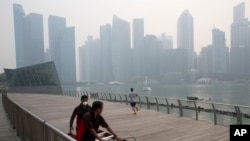The United Nations says the rising level of air borne pollution in Asia is extracting greater social and economic costs leading to millions of people dying prematurely each year.
Globally some seven million people a year die prematurely due to indoor and outdoor pollution with about 70 per cent of those deaths in the Asia Pacific.
From forest fires with their smoky haze over South East Asia, to China’s smog-filled mega cites, to rural homes in South Asia choked by inefficient stoves, scientists say in Asia there are rising health and social costs from air borne particle pollution.
Kaveh Zahedi, the UN’s Environment Program (UNEP) regional representative for Asia and the Pacific, says the costs from air pollution are rising for millions across the region, with hundreds of cities facing pollution levels exceeding World Health Organization (WHO) safety standards.
“Air pollution, air quality has to be one of the top priorities," said Zahedi. "We know that well over 200 cities in Asia exceed WHO guidelines on PM2.5 emissions. With millions of people living in them exceeding WHO guidelines which is directly linked with basically chronic health problems.”
The UNEP this week brought together more than 120 scientists, government officials, academics and a range of international organizations aiming them to develop a joint program to tackle air pollution in the region.
Human toll
Scientists warn that without significant steps, the number of premature deaths from air borne pollution will double by 2050.
In South Asia, from Bangladesh to India and Pakistan, the toll to human life has been directly linked to people using stoves that burn solid cooking fuels, like wood or dung.
Kalpana Balakrishnan, director of the WHO’s Collaborating Center for Occupational and Environmental Health, says this indoor pollution is a major contributor to health problems that compares to the pollution faced by urban communities with traffic borne smog.
“The burdens are high," she said. "The nature of the burdens on health – so it’s not just a kind of respiratory problem, but it’s also a cardiovascular problem. And it’s not just young children’s and women’s problem but across all age groups — men and women — everybody’s impacted — it makes it the top most public health environment concern.”
Balakrishnan says in India alone some 3.5 million deaths a year are attributable to household air pollution. But she adds India’s economic growth and rising incomes has led to more families to seek alternatives to solid fuels, such as liquid petroleum gas.
Atmospheric brown clouds
Atmospheric brown clouds (ABCs) over mega cities from Bangkok, Japan, China and throughout India, also extract serious costs to communities, says Teruyuki Nakajima, director of Japan’s Aerospace Exploration Agency and chair of the UNEP’s Asian team focused on the smog.
“Reducing the Asian pollution is very important. That is the vulnerable groups like the small children and people in poverty and also the aged people in Asia," said Nakajima. "Like in China and Japan their societies are getting old with more aged people, they may have some asthma problem and stroke and the particle matters really affect those people.”
Amid the smoke haze crisis in Singapore this year, the government took legal action against at least six Indonesian companies. At the same time, China is reported to be increasing investment to curb severe pollution in major cities, both the capital and regionally.
But U.N. scientists say more must be done than merely punishing polluters. They say the challenge lies in ensuring there is the political will to enforce existing environmental laws and cooperate on cross border problems such as smoke haze and other atmospheric pollution.









